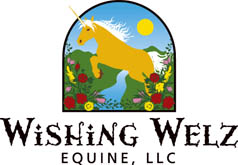Hoof Corner: Our Way of Trimming Heels
by James & Yvonne Welz ©2008
Really, we don't feel like this is our way - it is actually the mustang's way. Here, take a look:
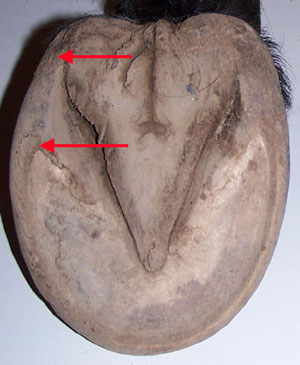
(mustang hoof photo courtesy Pete Ramey)
This is a cadaver hoof from a mustang that died in the wild. Please study the heel area. The top arrow points to the back of the hard horn at the heels, which is the rear-most weightbearing area. This is the "heel point" of the hoof (usually at the widest part of the frog) - but it is not a point, is it? The bottom arrow is the "heel turnaround point," which is the place where the wall turns sharply and becomes the bar. Notice how "low" and towards the middle of the hoof the heel turnaround point is? At first glance, this structure may be misinterpreted as underrun heels - but that's not what is going on at all! The heel does indeed end all the way at the rear of the frog.
How many domestic hooves do you see where the heel turnaround point is nearly the same location as the heel point? We observe that most are. Is that natural?
This wild mustang is not standing on a point, but rather sitting on a platform at the rear of its hoof. The rear of the bar and the hoof wall unite at the back of the foot and provide a solid, stable area for weightbearing. Notice how "sturdy" these heels look. We now describe this area between the heel point and the heel turnaround point as the "heel platform." (This general area has also been described by others as the "heel purchase" or "heel buttress," but those terms are sometimes also used to indicate the heel point or heel turnaround point!)
Here's another look, with the heel platform area outlined in red:
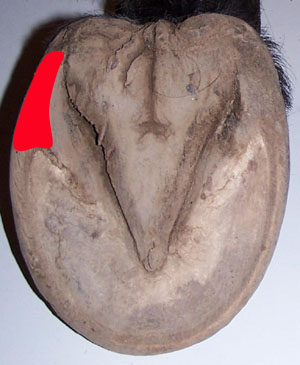
More mustang hooves, with the heel turnaround point and the heel point marked with red arrows. Notice the long distance between the two points.
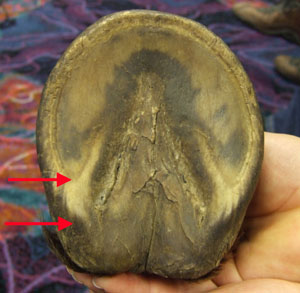
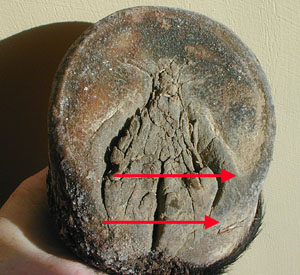
Look at the short distance between the points in typical domestic hooves with “ordinary” trims! What’s missing?
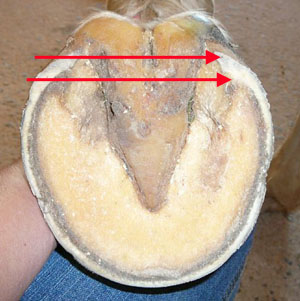
What’s missing in the domestic hooves with ordinary trims is THICKNESS of the wall. The space between the heel turnaround point and the heel point reflects nothing more than the thickness of the hoof wall. These typical domestic hooves have thin walls, and ordinary trimming methods (and any situation of peripheral loading) will perpetuate thin walls. Using our trimming method, you will create thick walls, and these thick walls will create a long heel platform as a result.
Healthy wild horse hooves have thick walls, and long heel platforms. Horses trimmed in our method for a period of time have thick walls, and long heel platforms. Here are examples of our trim, with the same arrows marking the same points:
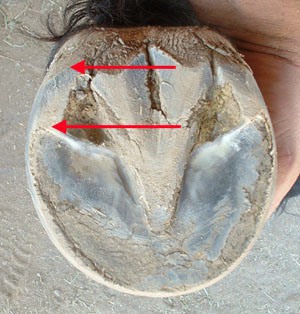
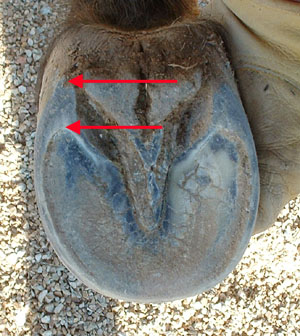
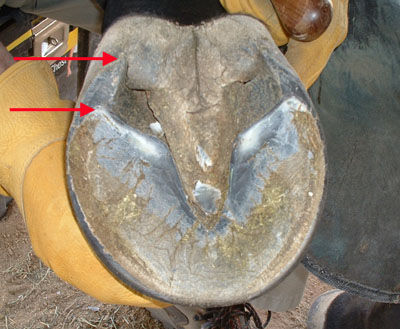
Note: the heel platform is not actually FLAT (hard to see in photos). The heel platform, and the heel itself, are rounded and beveled out from the water line -- just like the rest of the wall.
Keep in mind that the heel platform cannot necessarily be created in one trim (and can't be trimmed into a hoof when it isn't there in the first place!). The hoof has to grow and develop this feature, and your trim must encourage its development - which is natural. Also, the platform cannot be created without upright, functional bars (the platform is always missing on horses with weak bars) - so bar shaping is a crucial part of this. The healthier the hoof, the sturdier the appearance of the platform.
Since adopting and encouraging this heel platform in our trimming style many years ago, we had a drastic improvement in the soundness and health of our horse's hooves. We consider this to be a CRUCIAL part of successful barefoot trimming. It may be the missing piece for many folks who are still struggling. We'll provide more how-to information in future articles.
(August 2008)
This area of The Horse's Hoof represents OUR own personal opinions and recommendations regarding hooves and hoof care. We are James & Yvonne Welz, owners of The Horse's Hoof Magazine and website. While the emphasis of The Horse's Hoof is to promote barefoot as a whole, and provide a place for practitioners of all methods to gather and interact, we do have our own personal way of doing things. Throughout this past decade, we have been quietly practicing barefoot horse care on hundreds of horses, ironing out what really works, and here we will share our knowledge with you.
